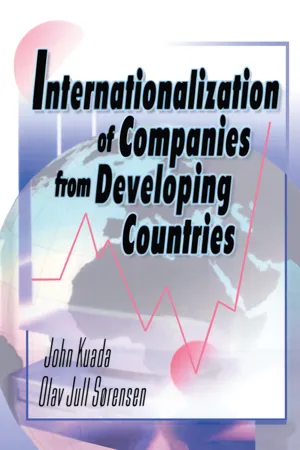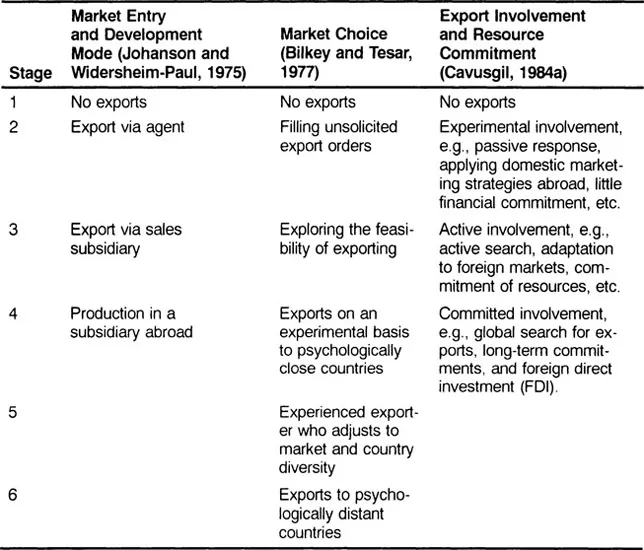
- 240 pages
- English
- ePUB (mobile friendly)
- Available on iOS & Android
Internationalization of Companies from Developing Countries
About This Book
Explore new international economic and business trends and how your firm can benefit from them!Internationalization of Companies from Developing Countries provides marketing and economic researchers and students with both theoretical and empirical insights into the motives, methods, and processes of internationalization of firms in the developing countries of Africa. Full of current facts and data, this informative book explores how government policies shape a country's strategies for global competitiveness. The book also discusses motives of internationalization, approaches to market analysis and market knowledge acquisition, and domestic and foreign interfirm relations. Informative and intelligent, Internationalization of Companies from Developing Countries offers you a unique conceptual framework for analyzing and understanding the internationalization process of successful Ghanaian firms and how these principles can be applied to other businesses in developing countries. This unique book will assist you in keeping current with the dynamics of the international market by supplying you with important guidelines and suggestions. It covers:
- the limitations of contemporary theories that explain the process of internationalization and export development
- how companies from a developing country become integrated in the global economy
- how governments can support the internationalization process
- three prototype orientations of management decisionmaking: planning orientation, action orientation, and network orientation
- various ways of entering and developing a foreign market
- the concepts of relationship and interaction as they pertain to international business, especially the relationships between government institutions and corporations Comprehensive and concise, this valuable book fills a void in the current literature about internationalization in developing countries, especially in Africa. Internationalization of Companies from Developing Countries will help you establish productive business relationships and improve the position of your company and its partners in today's global arena.
Frequently asked questions
Part I:
Internationalization Theories and Issues of Developing Country Firms
- Export behavior and foreign market entry decisions can be viewed as innovation adoption behavior; the innovation can be traced to an innovator, i.e., the decision maker in the firm.
- The export development process proceeds in a sequential, stagelike manner with the tempo of internationalization and the degree of resource commitment, contingent on a number of factors, including individual characteristics of managers.
- Exporter profiles can be used in ascertaining identifiable characteristics of firms at different stages in the internationalization process.
- A leading determinant of export behavior is firm size and its related amount of resources and managerial skills.
- place the study within the existing frame of knowledge in the area and
- examine the degree of consistency of the empirical results presented here with the major theoretical viewpoints in the existing literature.
Chapter 1
Theories and Models of Internationalization
Categorization of Theories of Internationalization
- Stages Models (the universal path of internationalization)
- Contingency Models (the adaption-planning approach to internationalization)
- (Inter)Action Models (internationalization achieved by seizing international opportunities through networking)
- An objective versus a subjective worldview
- A static versus a dynamic perspective
- A planning versus an action orientation
Objective versus Subjective Worldview
Static versus Dynamic Perspective
Planning versus Action Orientation
| Scientific Dimension | Stages Models | Contingency Models | (Inter)Action Models |
| | |||
| Objective versus subjective world-view | Objective | Objective | Subjective (shared understanding) |
| Static versus dynamic perspective | Comparison of static analysis at each stage | Static | Dynamic |
| Planning versus action orientation | Planning | Planning | Interaction |
| Managerial implications | Identify present stage; prepare and plan for the next | Build and use analytical capability | Build and use social capital, i.e., interaction capability |
The Stages Models
- Models showing internationalization to be based on learning and the accumulation of experience—the Learning Stages Theory
- Models showing internationalization to be based on adaption to changes in the environment, i.e., to changes in supply, demand, and competition—the International Product Life Cycle Theory
The Learning Stages Theory

- According to the rationale of the Stages Models, internationalization is based on the laws and principles of learning combined with risk taking. A company learns from its actions, and when it has acquired enough experience and reached an acceptable risk level, it is ready to take another step on the internationalization path. As all companies follow this rule of risk reduction through learning, a common internationalization pattern emerges.
- Related to the first explanation, a general pattern may also be found either because companies are managed by people who have acquired the same management philosophy and the same management tools or because companies learn from one another and imitate the behavior of more successful companies at any given point in time. In these instances, a common pattern will emerge based on common worldviews and, in general, the emergence of a common business culture or system (Whitley, 1992).The remarkable performance of many Japanese companies on the global market without the use of Western approaches to management is a clear indication that no universal approach to management exists.
- A general pattern may also be explained by the structure of an industry. For example, a general pattern of development will emerge in industry structures that include many small autonomous companies that are influenced by common social relations. An example is the well-known product life cycle, which reflects the numerous consumers who autonomously, but under social influence, decide to adopt a certain product. In this case, a combination of structural forces and social influence leads to a common pattern of behavior.Thus, the combination of the presence of many actors and a social interaction without social control lays the foundation for the emergence of general patterns of internationalization. The laws, however, are not natural laws; they are laws based on the mechanisms of social relations.Transferring this line of thinking to the internationalization of companies, we expect to find general patterns of internationalization in industries with numerous small-scale companies...
Table of contents
- Cover Page
- Half Title page
- Title Page
- Copyright Page
- Contents
- Acknowledgments
- About the Authors
- Abbreviations
- Introduction
- Part I: Internationalization Theories and Issues of Developing Country Firms
- Part II: Empirical Evidence
- Part III: Reassessment of Internationalization Theories
- Appendix A Dominant Contingency Models of Internationalization
- Appendix B Firms That Participated in the Study
- Appendix C Product Associations in Operation As of December 1995
- Appendix D Survey Questionnaire
- Notes
- Bibliography
- Index